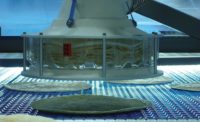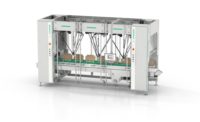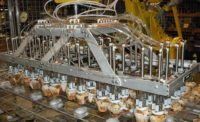More bakers and snack food manufacturers are packing their products in shelf-ready packaging for retailers. This trend is fueling demand for automated product-handling solutions that can move physical product as well as manage order and inventory data. To meet these needs, equipment manufacturers have developed systems ranging from advanced robotics and sophisticated conveyor systems to multifunctional plastic pallets. All are designed to offer flexible solutions that address changes in the marketplace.
“Due to evolving market demands, in particular product packaged in flexible bags, we have seen further migration toward shelf-ready packaging where a shipping case easily transitions into a display used on the store shelf,” says Rocco Fucetola, northeast regional sales manager for BluePrint Automation Inc., Colonial Heights, Va. “The goal is to provide increased value in areas of product identification, easy-open features and disposal and a better shelf presence. Requirements for lower case counts with single-shelf facings have become more prevalent, in addition to initiatives to reduce corrugate waste.”
In response to market demand, BluePrint Automation introduced a high-flow robot end effector designed for multiple applications, such as stacking hotcakes, waffles, tortillas, pitas and flatbreads and loading them directly to the flights of either a cartoning or flowrapping system. It features a vision system that recognizes and tracks product as it travels randomly from ovens, freezers or coolers. The system allows for defect detection. Benefits to the bakeries and snack manufacturers include a reduction in labor and repetitive motion operations and improved product stack control and placement.
Keeping services in-house
“Demands for flexible solutions are more pervasive today than in the past,” says Matt Wicks, vice president of product development–manufacturing systems, for Intelligrated, Downers Grove, Ill. “Robotics and flexible automation solutions that can accommodate changes in packaging and processes are on the rise.”
To respond to growing consumer demand for variety packs of foods, Intelligrated offers Alvey Robotic Variety Pack Solutions. These single-source, automated material-handling systems are scalable and designed to meet any bakers’ or snack manufacturers’ unique requirements and budget. “Now 3PLs (third-party logistics providers) can take advantage of automating contracted variety pack jobs, or manufacturers can recover costs and keep the process in-house,” Wicks notes. “We also have developed patented tooling that saves floorspace and eliminates the need for tool-changing devices.”
SAS Automation LLC, Xenia, Ohio, introduced a line of bakery depanning end-of-arm tools (EOATs) to automatically depan snack cakes, muffins, cupcakes, brownies, layer cakes and loaf cakes from baking pans. The depanning is accomplished with vacuum cups or stroking needles, depending on the product, fillings and toppings used.
Mounted on robots, depanning EOATs allow for faster product removal from the pans and greater accuracy when placing the pans into retail trays, clamshells or tubs. Manual filling of containers is no longer necessary and product damage from “dump depanners” is eliminated, according to John M. Prater, technical sales specialist at SAS Automation.
“Consumer demand for less wasteful retail packaging, coupled with better product presentation on the shelf, are driving changes in how products are packaged for sale,” he says. “To be effective, depanners must remove the baked goods with minimal impact to the appearance, and then manage the spacing differences from the baking pan to the retail container.”
Conveying new ideas
In the area of conveyor innovations, Heat and Control Inc., Hayward, Calif., introduced a number of conveyor systems, including the FastBack FDX horizontal motion conveyor. FDX provides the benefits of the FastBack (near-zero product damage, quiet operation, no product segregation of blends, no seasoning loss and buildup in the conveyor pan) in a small, single drive that can handle production runs 100 ft. long, says Blake Svejkovsky, manager of product handling systems.
“This drive makes up the basis for our new SwitchBack 2.5 and SwitchBack 10.0 accumulation systems, which provide gentle and ultra-clean accumulation capacities of 2.5 and 10 cu. meters, respectively, and provide an alternative to belted accumulation systems that are typically used,” he explains.
Meanwhile, Shuttleworth, Huntington, Ind., offers the V-Clean system, which complements its line of industrial and Easy Clean conveyors, and offers bakers and snack producers a full range of material-handling solutions, including wipe-down, heavy washdown and nonwashdown systems. The stainless-steel-frame V-Clean conveyor with Slip-Torque technology provides precise, continuous transport that improves throughput and minimizes product damage, according to Todd Eckert, business development director.
“V-Clean offers customers a durable, advanced-handling, light-wash solution that is a high-value alternative to the expense of a heavy washdown system,” he says. “It includes the line efficiency and gentle handling advantages of our Slip-Torque technology, and fits the needs and budgets of food companies that have light wash requirements.” Eckert adds that more bakers and snack producers are asking for entire turnkey solutions, going beyond conveyors.
New pallet configurations
In a related area of product handling, ORBIS Corp., Oconomowoc, Wis., recently launched a series of plastic pallets available with x-ray and metal-detectable material formulations. One example is the RackoCell, a 40x48-in. molded polypropylene pallet that offers enhanced stiffness and edge-racking performance for up to 2,200 lb. It features a flow-through design that washes and drains quickly for high sanitation.
The RackoCell pallet also features an option available specifically for food manufacturers that use x-ray detection to inspect loads prior to shipping. “The new RackoCell option is molded with a blend of detectable materials and is x-ray-compatible,” says Curt Most, senior product manager. “In case a piece of the pallet comes loose due to aggressive handling, it can be detected, depending on the detection machine strength and composition blend of the pallet. This allows plants to use fully hygienic pallets throughout their internal processing facilites. When loads are off-loaded to outbound shipping pallets, they can be sent through x-ray machines for inspection.”
The issue of food allergies is gaining importance, Most adds. “Food processors are making products that are free from nuts, gluten, dairy and soy,” he says. “There is lots of growth in gluten-free foods—from basic gluten-free breads to pizza crust and burger buns. This drives the need to separate, store and mark ingredients within a plant, whether it be through color-coded pallets or labels.”
In the near future, food manufacturers will demand new shipping case designs for fewer product counts, according to Fucetola of BluePrint Automation. Therefore, his company is developing a case-packing solution that can run multiple types of cases (regular-slotted containers [RSCs], wraparounds, shelf-ready, retail-ready and trays) on the same system. “Producers will look at ways to reduce corrugated costs in the face of having to reduce case counts due to case and a half,” he says. “This system also will incorporate a simple means for loading product into the case.”












